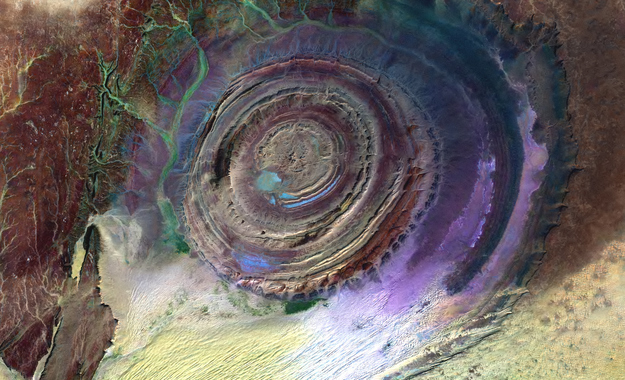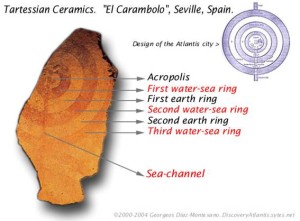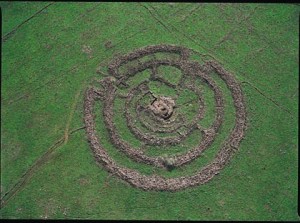Concentric rings
Nicholls, Melville
 Melville Nicholls is a senior research scientist at the University of Colorado where he studies atmospheric science, mainly relating to hurricanes. In May 2013, he published Children of the Sea God[944] as a Kindle ebook. One of his main contentions is that Atlantis existed during the early Bronze Age at the time of the Bell Beaker culture, >which he claims originated in Portugal around 2800 BC.<
Melville Nicholls is a senior research scientist at the University of Colorado where he studies atmospheric science, mainly relating to hurricanes. In May 2013, he published Children of the Sea God[944] as a Kindle ebook. One of his main contentions is that Atlantis existed during the early Bronze Age at the time of the Bell Beaker culture, >which he claims originated in Portugal around 2800 BC.<
He also contends that Britain was the large island of Atlantis described by Plato. However he also proposes that the main port city of Atlantis, with the concentric rings of land and water was situated in southwest Spain near Gibraltar. He proposes that this port was destroyed by an event such as a tsunami.
While all these features have been proposed individually as characteristics of Atlantis, Nicholls brings them together in a comprehensive theory, but not without indulging in a liberal amount of speculation.
He devotes a considerable amount of space attempting to link Stonehenge with the Atlanteans. While I was not won over by Nicholl’s book, it is worth a read and might best be studied along with Donald Ingram’s book, The Unlost Island[665].
The idea of ‘two’ Atlantises was probably first promoted by Lewis Spence and more recently by Karl Jürgen Hepke. In fact, were there not ten Atlantises?
In November 2013, Nicholls published a second ebook, The Real and Imaginary Atlantis[945], in which he revisits his theory of a British/Spanish Atlantis and its relationship to the Bell Beaker People. In conclusion, he seems to reluctantly write that “I still come down in favor of the theory that Plato invented the story as the one most likely to be correct.”
Richat Structure, The
The Richat Structure or Guelb er Richat in Mauritania” is regarded by geologists as a highly symmetrical and deeply eroded geologic dome. It was first described in the 1930s to 1940s, as Richât Crater or Richât buttonhole. Richard-Molard (1948) considered it to be the result of a laccolithic thrust. A geological expedition to Mauritania led by Théodore Monod in 1952 recorded four ‘crateriform or circular irregularities” in the area.”(q)
The feature was thought by  many to be an impact crater until it was identified as the remains of a possible ‘salt dome’(a). Some of the more enthusiastic supporters of the ‘Electric Universe’ school of thought have sought to identify the feature as the consequence of an electrical discharge.(e)
many to be an impact crater until it was identified as the remains of a possible ‘salt dome’(a). Some of the more enthusiastic supporters of the ‘Electric Universe’ school of thought have sought to identify the feature as the consequence of an electrical discharge.(e)
This is outlined in an April 2022 paper by Andrew Hall, explaining what he calls the ‘Keystone Pattern’.(r)
Even creationists have claimed that the original surface of the ‘Structure’ had been eroded by Noah’s Flood(t).
The concentric circles of which the structure is composed is clearly revealed by satellite imagery. However, these characteristics are not visible when walking across the structure(u). The scientific consensus today is that the structure is a natural geological feature. In more technical terms a geological ‘dome’ is “A structure that plunges in all directions to form a circular or elongate structure is a dome. Domes are generally formed from one main deformation event, or via diapirism from underlying magmatic intrusions or movements of upwardly mobile, mechanically ductile material such as rock salt (salt dome) and shale (shale diapir). The Richat Structure of the Sahara is considered a dome that has been laid bare by erosion.”(k) Further geological data was available on a German website(v).
It did not take long before it was compared to Plato’s description of Atlantis. However, Ulf Richter has pointed out that it is too wide (35 km), too elevated (400 metres) and too far from the sea (500 km) to be seriously considered the location of Atlantis. Nevertheless, researchers such as Robert deMelo are still prepared to consider it a possible location candidate(b).
50 km west-southwest of Richat is a similar though smaller feature, the Semsiyat Dome, having a diameter of just 5 km(o).
In 2008, George Sarantitis put forward the idea that the Richat Structure was the location of Atlantis, supporting his contention with an intensive reappraisal of the translation of Plato’s text(g). His theory has been published in Greek[1470], with an English translation now (2017) imminent.
In 2006 George S. Alexander and Natalis Rosen were struck by the similarity of the Richat feature with Plato’s description and decided to investigate on the ground. Instability in the region prevented this until late 2008 when they visited the site, gathering material for a movie. The film was then finalised and published on their then-newly-established website in 2010(c).
In 2008, Charles Giuliani self-published Alternative View of The Distant Past [1969]. In this wide-ranging book, the author tackles the story of Atlantis and endeavours to identify the Richat Structure as the location of Plato’s city of Atlantis. His speculations lack scientific evidence and contradict reason. The main weaknesses are his dating of Atlantis (9600 BC) and the logistical problems of launching an attack on Athens 4,000km away from Richat at a time when archaeology indicates that seafaring was carried out with little more than dugout canoes or rafts.
In 2013 further support for linking Atlantis with Richat came from Jose D.C. Hernandez with a rather convoluted theory in a paper entitled A Celestial Impact and Atlantis(f).
Even more bizarre is the claim by Anthony Woods that although Ireland was the island of Atlantis, the city of Atlantis (Cerne) was in Mauritania and is known today as the Richat Structure!
Towards the end of the 2018 media ‘silly season’, the YouTube channel Bright Insight made a pathetic attempt to breathe new life into the Atlantis in Sahara theory. However, it fails on one simple fact; it is not submerged, but for good measure, when Alexander and Rosen investigated the Richat Structure they could not produce a single piece of physical evidence from the 35 km wide site. Where was the bustling port described by Plato? I could go on, but remember, it’s not called the silly season without reason.
Early November 2018 saw the British tabloid press give further coverage to Jimmy Corsetti’s ideas(i)(j) (The Sun gave his name as Jimmy Bright!). His theories are totally dependent on the destruction of Atlantis having occurred around twelve thousand years ago. He does not explain how an attack was launched from Mauritania on Athens which did not even exist at that time. Corsetti, like many others, needs this very early date to explain why the Richat Structure is not underwater today but was gradually uplifted as a result of tectonic forces in the region. However, Plato clearly states that the submerged Atlantis was still a hazard to shipping in his day, a period when the Structure would have been at its present elevation. As no geologic event has occurred during the two and a half millennia since Plato, which could have raised the Structure from the seabed to an elevation of 400 metres 500 km from the Atlantic, we are obliged to give greater credence to the scientific conclusion that the Richat Structure is a natural feature. Corsetti does have at least one fan(n).
It was in 2018 that Corsetti published a video promoting the Richat Structure as Atlantis, which received extensive coverage. Steven Novella, a well-known Atlantis sceptic, published an article debunking Corsetti’s ‘evidence’ in some considerable detail(s). However, while I would endorse Novella’s arguments(l) regarding the Richat Structure, I strongly disagree with Novella’s closed-minded attitude towards the existence of Atlantis as well as Corsetti’s attention-seeking location choice for Plato’s island. I would add that Corsetti has his date wrong and that to launch an attack on Athens nearly 4000 km away by land (3000 km by sea) from the ‘Structure’ is logistical nonsense.
In a recent conversation with Joe Rogan, Corsetti claimed that since the Structure contains salt, it MUST have been submerged and no other explanation is possible. However, as I have pointed out above the Richat feature is an eroded ‘salt dome’ and quite naturally has salt in it without the need for submersion.
>The natural geological origins of the Richat Structure are discussed in some detail in a 2005 paper by three Canadian scientists in the journal Geology, produced by the Geological Society of America. It would be interesting to hear the response of Corsetti to facts compared with his daft speculations(w).<
However, in 2018, Martin K. Ettington published a booklet entitled The Real Atlantis [1641] in which he also insisted that the Richat Structure is the remains of Atlantis but with no real evidence to support his contention.
In Joining the Dots [1590] and in Atlantipedia.ie I have consistently argued that in ancient times, proximity is an essential logistical requirement in order to achieve a successful invasion. This was particularly true in ancient times when all empires expanded through the invasion of neighbouring territories. The Richat Structure is many thousands of kilometres from Athens, so to suggest that an attack was launched from Mauretania on Greece is simply ludicrous.
There is a relatively recent website(m) dedicated to promoting the ‘Structure’ as the location of Atlantis. It is well presented by its author Gergely (Gregory) Dzsida with plenty of content. Unfortunately, I cannot accept its basic claim, To my mind, it fails to answer Richter’s arguments regarding, size, elevation and location as well as my point regarding proximity.
Not unexpectedly, Jason Colavito has a few thoughts to add to this latest Atlantis in Sahara kerfuffle(h).
Although the Richat Structure as the location of Atlantis conflicts with details in Plato’s account as well as reason, it still gathers supporters based simply on its circular shape. A recent example of this came from a Danish commentator, Palle A. Anderson(p).
An even more ridiculous suggestion was offered in 2021 by Carlos Bisceglia in Atlantis 2021- Lost Continent Rediscovered in which he proposed that Atlantis was known to the Egyptians as the ‘Land of Ma’ and that its capital was the Richat Structure together with the Semsiat Dome, mentioned above, which is 50km away. In order to explain how his Atlantis is not submerged, Bisceglia has proposed that the Land of Ma became confused with the submerged Land of Mu (Sundaland) in the Pacific and that “it is possible that Solon or Plato confused ‘the Land of Ma’ with the ‘Land of Mu’, and thus two completely independent accounts were merged into one.” He adds “how the Egyptian priests knew this is a mystery. Evidently, some survivors from Sundaland arrived in some way in Egypt”
In April 2022, David Edward published Atlantis Solved: The Final Definitive Proof [1926], which also endorsed the Richat Structure as the location of Atlantis. The author of this slender 99-page book admits to being greatly influenced by the earlier claims of Jimmy Corsetti.
(a) https://web.archive.org/web/20160326200714/https://www.atlantis-schoppe.de/richter.pdf
(b) http://www.gpofr.com/documents/2012Atlantis.pdf
(c) Visiting Atlantis | Gateway to a lost world (archive.org)
(e) https://www.thunderbolts.info/tpod/2005/arch05/050407richat.htm
(f) https://blog.world-mysteries.com/science/a-celestial-impact-and-atlantis/
(g) The System of Wheels – Plato Project (archive.org)
(h) https://www.jasoncolavito.com/blog/youtube-video-claims-atlantis-is-located-in-the-sahara-desert
(i) https://www.thesun.co.uk/news/7681682/atlantis-sahara-desert-conspiracy/
(l) https://theness.com/neurologicablog/index.php/no-atlantis-has-not-been-discovered-in-north-africa/
(m) Learn from Ancient Civilizations | Find Atlantis Together (archive.org)
(o) http://www.b14643.de/Mauritania-Craters/index.htm (see the end of page)
(p) The Real Atlantis – where is it? (planker.dk)
(q) Richat Structure – Wikipedia
(r) The Keystone Pattern – The Thunderbolts Project™
(s) https://theness.com/neurologicablog/index.php/no-atlantis-has-not-been-discovered-in-north-africa/
(t) https://creation.com/eye-of-the-sahara
Neel, Jesse
Jesse Neel promotes the idea that Atlantis had existed on what was an extended Yucatan Peninsula before the ending of the last Ice Age(a). He bases this idea  on a review of the Piri Reis Map. He contends that famous Chicxulub impact crater had concentric features that were later incorporated into the topography of the city of Atlantis and subsequently submerged as the Ice Age glaciers melted. However, any such features would have had dimension far in excess of what Plato describe’.
on a review of the Piri Reis Map. He contends that famous Chicxulub impact crater had concentric features that were later incorporated into the topography of the city of Atlantis and subsequently submerged as the Ice Age glaciers melted. However, any such features would have had dimension far in excess of what Plato describe’.
Marini, Paolo (L)
Paolo Marini (1940- ) was born in Rome, has a degree in Chemistry and works at the National Institute of Nuclear Physics in Frascati. He has a great interest in prehistory, which has led him to enter the minefield of Atlantology.
He has written Atlantide: Nel cerchio di Stonehenge la chiave dell’enigma (Atlantis: The Circle is the Key to the enigma of Stonehenge)[713]. The subtitle refers to his contention that the concentric circles of Atlantis are reflected in the layout of Stonehenge! He further claims that the almost simultaneous emergence of Sumeria, Egypt and the megalith builders was ‘probably’ the result of a cultural impetus given by survivors from Atlantis. Marini identifies the Azores as the remnants of Atlantis. All highly speculative.
Jaén
Jaén is a large town north of Granada in Andalusia, Spain, which Georgeos Díaz-Montexano has claimed had an ancient configuration consisting of concentric rings similar to Plato’s description of Atlantis. He supports this idea with an extensive website(a) about the city. Elsewhere(b) he including an image of concentric rings painted on pottery found in Jaén, which is now in the National Archaeological Museum in Madrid. (see image here)
>Atlantisforschung has an interesting article about Jaén, including comments from Diaz-Montexano in which he excludes Jaén as the site of Atlantis on the grounds of its elevation and distance from the sea(c).<
Stuart Webb in his brief book[1153] noted that “the Romans called this strange place ‘Auringis’ from the Greek ‘Ouringis’ although neither Romans nor Greeks were its builders. Díaz-Montexano speculates that Auringis or Ouringis translates into the ‘city of the rings’ from an ancient Indo-European word meaning the ‘Ring’.
(a) Wayback Machine (archive.org) (English & Spanish)
(b) Reportaje “Expedición Jaén Atlante 2019” con Georgeos Díaz-Montexano – ARGARICA (archive.org) (Spanish)
(c) Jaén in Andalusia – a daughter city of Atlantis? – Atlantisforschung.de (atlantisforschung-de.translate.goog) (English) *
Faro *
Faro in Portugal has been linked with the Greek Pharos or lighthouse. Roger Coghill offers an ingenious theory on the origin of Faro’s name and connects it with Plato’s Atlantis(c). I have taken the liberty of quoting from his website(a) which is at least worth a read.
“That beacon is exactly what Faro (Pharos is Greek for lighthouse) I believe provided, at its location in the middle of that otherwise inhospitable coastline, exactly where Plato described it.
The question is, if this is right, how could such a primitive civilisation have provided a continuous lamp, bright enough to be seen thirty miles offshore in unsettled weather? (Further than 30 miles it would have been below the horizon. Sailing downwind in a real gale one has scarcely time to make a major course correction in thirty miles: you only have one chance!
I believe that the answer lies not on the coast, but inland of Faro, where there are the world’s largest and most ancient copper and zinc mines lying adjacent to each other, and have given rise to today’s commercial giant, the RTZ Corporation, which stands for Rio Tinto Zinc. The Rio Tinto flowing down to that part of the Atlantic coast is so called because of its alluvial copper. Any schoolboy today knows that you can make a voltaic battery quite capable of lighting any filament lamp by simply connecting copper to zinc.
The first schoolboy ever accidentally to discover this may plausibly have lived a little inland from modern Faro, since the two component materials were plentiful and to hand. It is my speculation that here in this fertile cradle of civilisation was first discovered the ability to make electrons flow and thereby create primitive electrical energy.
Plato helps us into this belief: he explains how the city was built as a city with three concentric rings, each ring being clad with a different metal and in the centre a beacon “shone like a torch”. It is important for scholars to note that the words Plato used are not those suggesting reflected light, as in a mirror, but of intrinsic light, self- generated. What Plato is describing then is a city built as a huge lighthouse and plausibly powered by the electrical current flowing between copper and zinc cladding, separated by huge walls.”
In 2006 Larry Radka(b) edited The Electric Mirror on the Pharos Lighthouse and Other Ancient Lighting[0948], which according to one commentator is a reworking of a much older work. In it, is the claim is made that the famous Pharos lighthouse was powered by electricity. All we have is a coincidence of two similar sounding names (Faro & Pharos) and their alleged identical function combined with speculation, but no evidence at either site.
While Radka’s claim is rather extreme, Robert Temple in The Crystal Sun is more restrained where he refers to a 16th century account of a telescope at Pharos in the 3rd century BC, implying the existence at that early date of some optical technology and its possible use in the lighthouse there [928.128]. Temple’s entire book is devoted to proving that the science of optics is much older than generally accepted. When we consider the Antikythera Mechanism or the ‘Baghdad Battery’, it may be unwise to be too dismissive of Temple’s conclusions in this regard.
(a) https://web.archive.org/web/20121122090109/https://www.cogreslab.co.uk:80/prehistory.asp (Link broken) *
(b) https://www.bibliotecapleyades.net/ciencia/ciencia_hitech05.htm
(c) Archive 2086 | (atlantipedia.ie)
Concentric Rings *
The Concentric Rings or other architectural features extracted by artists from Plato’s description of the capital of Atlantis have  continually fascinated students of the story and many have attempted to link them with similar ancient features found elsewhere in the world as evidence of a widespread culture. Stonehenge, Old Owstrey, Carthage and Syracuse have all been suggested, but such comparisons have never been convincing. Diaz-Montexano has recently published(a) an image of a fragment of pottery found near Seville in Spain that shows concentric circles and insists that it is a symbol of Atlantis. Ulf Erlingsson has made a similar claim regarding some concentric circles carved on a stone basin found at Newgrange in Ireland.
continually fascinated students of the story and many have attempted to link them with similar ancient features found elsewhere in the world as evidence of a widespread culture. Stonehenge, Old Owstrey, Carthage and Syracuse have all been suggested, but such comparisons have never been convincing. Diaz-Montexano has recently published(a) an image of a fragment of pottery found near Seville in Spain that shows concentric circles and insists that it is a symbol of Atlantis. Ulf Erlingsson has made a similar claim regarding some concentric circles carved on a stone basin found at Newgrange in Ireland.
Less well-known are the concentric stone circles that are to be found on the island of Lampedusa in the Strait of Sicily(b).
In 1969 two commercial pilots, Robert Brush and Trigg Adams photographed a series of large concentric circles in about three feet of water off the coast of Andros in the Bahamas. Estimates of the diameter of the circles range from 100 to 1,000 feet. Apparently, these rings are now covered by sand. It is hard to understand how such a feature in such very shallow water cannot be physically located and inspected. Richard Wingate in his book [0059] estimated the diameter at 1,000 yards. However, the rings described by Wingate were apparently on land, among Andros’ many swamps.
A recent (2023) report has drawn attention to the ancient rock art found on Kenya’s Mfangano Island where a number of concentric circles estimated as 4,000 years old can be seen(q).
Two papers presented to the 2005 Atlantis Conference on Melos describe how an asteroid impact could produce similar concentric rings, which, if located close to a coast, could be converted easily to a series of canals for seagoing vessels. The authors, Filippos Tsikalas, V.V. Shuvavlov and Stavros Papamarinopoulos gave examples of such multi-ringed concentric morphology resulting from asteroid impacts. Not only does their suggestion provide a rational explanation for the shape of the canals but would also explain the apparent over-engineering of those waterways.
At the same conference, the late Ulf Richter presented his idea [629.451], which included the suggestion that the concentric rings around the centre of the Atlantis capital had a natural origin. Richter has proposed that the Atlantis rings were the result of the erosion of an elevated salt dome that had exposed alternating rings of hard and soft rock that could be adapted to provide the waterways described by Plato.
Georgeos Diaz-Montexano has suggested that the ancient city under modern Jaen in Andalusia, Spain had a concentric layout similar to Plato’s description of Atlantis. In August 2016 archaeologists from the University of Tübingen revealed the discovery(i) of a Copper Age, Bell Beaker People site 50km east of Valencina near Seville, where the complex included a series of concentric earthwork circles.
A very impressive example of man-made concentric stone circles, known in Arabic as Rujm el-Hiri and in Hebrew as Gilgal Refaim(a), is to be found on the Golan Heights, now part of Israeli-occupied Syria. It consists of four concentric walls with an outer diameter of 160metres. It has been dated to 3000-2700 BC and is reputed to have been built by giants! Mercifully, nobody has claimed any connection with Atlantis. That is until 2018 when Ryan Pitterson made just such a claim in his book, Judgement of the Nephilim[1620].
Jim Allen in his latest book, Atlantis and the Persian Empire[877], devotes a well-illustrated chapter to a discussion of a number of ‘circular cities’ that existed in ancient Persia and which some commentators claim were the inspiration for Plato’s description of the city of Atlantis. These include the old city of Firuzabad which was divided into 20 sectors by radial spokes as well as Ecbatana and Susa, both noted by Herodotus to have had concentric walls. Understandably, Allen, who promotes the idea of Atlantis in the Andes, has pointed out that many sites on the Altiplano have hilltops surrounded by concentric walls. However, as he seems to realise that to definitively link any of these locations with Plato’s Atlantis a large dollop of speculation was required.
Rodney Castleden compared the layout of Syracuse in Sicily with Plato’s Atlantis noting that the main city “had seen a revolution in its defensive works, with the building of unparalleled lengths of circuit walls punctuated by numerous bastions and towers, displaying the city-state’s power and wealth. The three major districts of the city, Ortygia, Achradina and Tycha, were surrounded by three separate circuit walls; Ortygia itself had three concentric walls, a double wall around the edge and an inner citadel”.[225.179]
Dale Drinnon has an interesting article(d) on the ‘rondels’ of the central Danubian region, which number about 200. Some of these Neolithic features have a lot in common with Plato’s description of the port city of Atlantis. The ubiquity of circular archaeological structures at that time is now quite clear, but they do not demonstrate any relationship with Atlantis.
The late Marcello Cosci based his Atlantis location on his interpretation of aerial images of circular features on Sherbro Island, but as far as I can ascertain this idea has gained little traction.
One of the most remarkable natural examples of concentric features is to be found in modern Mauritania and is known as the Richat Structure or Guelb er Richat. It is such a striking example that it is not surprising that some researchers have tried to link it with Atlantis. Robert deMelo and Jose D.C. Hernandez(o) are two advocates along with George S. Alexander & Natalis Rosen who were struck by the similarity of the Richat feature with Plato’s description and decided to investigate on the ground. Instability in the region prevented this until late 2008 when they visited the site, gathering material for a movie. The film was then finalised and published on their then newly established website in 2010(l), where the one hour video in support of their thesis can be freely downloaded(m).
In 2008, George Sarantitis put forward the idea that the Richat Structure was the location of Atlantis, supporting his contention with an intensive reappraisal of the translation of Plato’s text(n). He developed this further in his Greek language 2010 book, The Apocalypse of a Myth[1470] with an English translation currently in preparation.
However, Ulf Richter has pointed out that Richat is too wide (35 km), too elevated (400metres) and too far from the sea (500 km) to be seriously considered as the location of Atlantis.
A dissertation by Oliver D.Smith has suggested(e) the ancient site of Sesklo in Greece as the location of Atlantis, citing its circularity as an important reason for the identification. However, there are no concentric walls, the site is too small and most importantly, it’s not submerged. Smith later decided that the Atlantis story was a fabrication!(p)
Brad Yoon has claimed that concentric circles are proof of the existence of Atlantis, an idea totally rejected by Jason Colavito(j).
In March 2015, the UK’s MailOnline published a generously illustrated article(g) concerning a number of sites with unexplained concentric circles in China’s Gobi Desert. The article also notes some  superficial similarities with Stonehenge. I will not be surprised if a member of the lunatic fringe concocts an Atlantis theory based on these images. (see right)
superficial similarities with Stonehenge. I will not be surprised if a member of the lunatic fringe concocts an Atlantis theory based on these images. (see right)
Paolo Marini has written Atlantide:Nel cerchio di Stonehenge la chiave dell’enigma (Atlantis: The Circle is the Key to the enigma of Stonehenge) [0713]. The subtitle refers to his contention that the concentric circles of Atlantis are reflected in the layout of Stonehenge!
In 2011 Shoji Yoshinori offered the suggestion that Stonehenge was a 1/24th scale model of Atlantis(f). He includes a fascinating image in the pdf.
This obsession with concentricity has now extended to the interpretation of ancient Scandinavian armoury in particular items such as the Herzsprung Shield(c).
For my part, I wish to question Plato’s description of the layout of Atlantis’ capital city with its vast and perfectly engineered concentric alternating bands of land and sea. This is highly improbable as the layout of cities is invariably determined by the natural topography of the land available to it(h). Plato is describing a city designed by and for a god and his wife and as such his audience would expect it to be perfect and Plato did not let them down. I am therefore suggesting that those passages have been concocted within the parameters of ‘artistic licence’ and should be treated as part of the mythological strand in the narrative, in the same way, that we view the ‘reality’ of Clieto’s five sets of male twins or even the physical existence of Poseidon himself.
Furthermore, Plato was a follower of Pythagoras, who taught that nothing exists without a centre, around which it revolves(k). A concept which may have inspired him to include it in his description of Poseidon’s Atlantis.
(b) Megalithic Lampedusa (archive.org)
(c) https://www.parzifal-ev.de/index.php?id=20
(d) See: Archive 3595
(e) https://atlantipedia.ie/samples/archive-3062/
(f) https://www.pipi.jp/~exa/kodai/kaimei/stonehenge_is_small_atrantis_eng.pdf
(i) First Bell Beaker earthwork enclosure found in Spain | ScienceDaily (archive.org) *
(j) https://www.jasoncolavito.com/blog/rings-of-power-do-concentric-circles-prove-atlantis-real
(k) Pythagoras and the Mystery of Numbers (archive.org)
(l) Visiting Atlantis | Gateway to a lost world (archive.org)
(m) https://web.archive.org/web/20171022134926/https://visitingatlantis.com/Movie.html
(n) https://platoproject.gr/system-wheels/ https://platoproject.gr/page13.html (offline Nov.2015)
(o) https://blog.world-mysteries.com/science/a-celestial-impact-and-atlantis/ (item 11)
(p) https://shimajournal.org/issues/v10n2/d.-Smith-Shima-v10n2.pdf
Cleito
Cleito was the daughter of Evenor and Leucippe [one writer has even sought to equate them with Eve and Lucifer!!]. Although Cleito was a mere mortal, she became the wife of Poseidon, the founder of Atlantis. According to Plato Cleito gave birth to five pairs of twins, of whom Atlas was the first born and was appointed as the primary ruler of Atlantis while his brothers reigned over the other nine kingdoms (or colonies?). In order to protect Cleito, Poseidon built a palace (Critias 113d) in the centre of Atlantis surrounded by the famous concentric rings of land and water, which according to some translations (including Jowett’s) were so perfect that it was as if they had been created on a lathe. I find it odd that people who accept that that Poseidon was a mythological figure, are not also prepared to accept his home as equally unreal. What I’m suggesting is that Plato’s description of the divine residence and its environs is just a literary invention and that it is an exercise in futility to look for an historical Atlantis that matches the architectural perfection depicted by Plato.
The story of Atlantis is unconnected to the rest of Greek mythology with the exception of references to Poseidon and Atlas.
Atlantis Conference – 2005
The Atlantis Conference – 2005 was addressed by a wide range of speakers who hold many conflicting theories regarding the truth behind Plato’s story. It was held on the Aegean island of Melos, which Dr. Galanopoulos suggested had been named after Eumelos, the brother of Atlas, king of Atlantis.
The conference concluded with agreement on a list of 24 criteria, which any proposed site must meet to qualify as a site where Atlantis could have existed:
1. The Metropolis of Atlantis should have been located where an island used to be and where parts of it may still exist.
2. The Metropolis of Atlantis should have had a most distinct geomorphology composed of alternating concentric rings of land and water.
3. The Atlantis should have been located outside the Pillars of Hercules.
4. The Metropolis of Atlantis was greater than Libya and Anatolia and Middle East and Sinai (combined).
5. Atlantis must have sheltered a literate population with metallurgical and navigational skills.
6. The Metropolis of Atlantis should have been routinely reachable from Athens by sea.
7. At the time, Atlantis should have been at war with Athens.
8. The Metropolis of Athens must have suffered a devastating physical destruction of unprecedented proportions.
9. The Metropolis of Atlantis should have sunk entirely or partly below the water.
10. The Metropolis of Atlantis was destroyed 9000 Egyptian years before the 6th century B.C.
11. The part of Atlantis was 50 stadia (7.5 km) from the city.
12. Atlantis had a high population density, enough to support a large army (10,000 chariots, 1,200 ships, 1,200,000 hoplites)
13. The region of Atlantis involved the sacrifice of bulls.
14. The destruction of Atlantis was accompanied by an earthquake.
15. After the destruction of Atlantis, the passage of ships was blocked.
16. Elephants were present in Atlantis.
17. No physically or geologically impossible processes were involved in the destruction of Atlantis.
18. Hot and cold springs, with mineral deposits, were present in Atlantis.
19. Atlantis lay on a coastal plain 2000 x 3000 stadia surrounded by mountains falling into the sea.
20. Atlantis controlled other states of the period.
21. Winds in Atlantis came from the north (only in Northern hemisphere)
22. The rocks in Atlantis were of various colours: black, white, and red.
23. There were canals for irrigation in Atlantis.
24. Every 5th and 6th year, they sacrificed bulls.
While it is interesting that a majority of the gathering supported a list of this nature, many of the individual points will be considered highly contentious by a number of investigators. For my part I see the principal flaw with the list is that it is built on the assumption that all of what Plato wrote is factual and not mythological and does not contain any errors or embellishments.
Jim Allen is also unhappy with aspects of this list and has expanded it by a further 26 criteria giving us a round 50 identification elements(a). Allen then applies this list to 24 Atlantis theories and surprise, surprise, all theories fail except his Andean theory. This expanded list includes all the original flaws plus new ones introduced to bolster Allen’s Bolivian theory.
This 2005 Conference is also notable for the contribution of Antonis Kontaratos, who used the occasion to list the twenty-two instances, both directly and indirectly, where Plato points to the Atlantis story as true.
The proceedings of the conference were subsequently published, in English, in a substantial and valuable volume, edited by Stavros Papamarinopoulos, entitled The Atlantis Hypothesis: Searching for a Lost Land[0629].
>(a) https://web.archive.org/web/20170724234247/http://www.atlantisbolivia.org/beyond24points.htm<
Ambrose, Henry B.
Henry B. Ambrose (1917-2010) was born in Grayhawk, Kentucky and later worked as a real estate broker in California. His contribution to the Atlantis saga  is the simple claim that “England was at one time the powerful kingdom of Atlantis”. He identifies Old Oswestry Hill Fort, Shropshire as its precise location. Mr. Ambrose is a most fortunate man, as he also claims to have found the Garden of Eden as well.
is the simple claim that “England was at one time the powerful kingdom of Atlantis”. He identifies Old Oswestry Hill Fort, Shropshire as its precise location. Mr. Ambrose is a most fortunate man, as he also claims to have found the Garden of Eden as well.
He has written three books[050][051][052] on his ‘discoveries’ and has published them privately. They are available through his website(a) . Unfortunately, I feel obliged to relegate Mr. Ambrose to the ever-growing ranks of eccentrics who have written about Atlantis.
The image of Ambrose’s Old Oswestry site reminds me of The Hill of Ward in Ireland, which also consists of a series of concentric circles. A pathetic attempt(b) has also been made to also link this Irish site with Atlantis.
(a) https://web.archive.org/web/20160307205930/https://ifoundatlantis.com/index.html
(b) See: Archive {2732}


